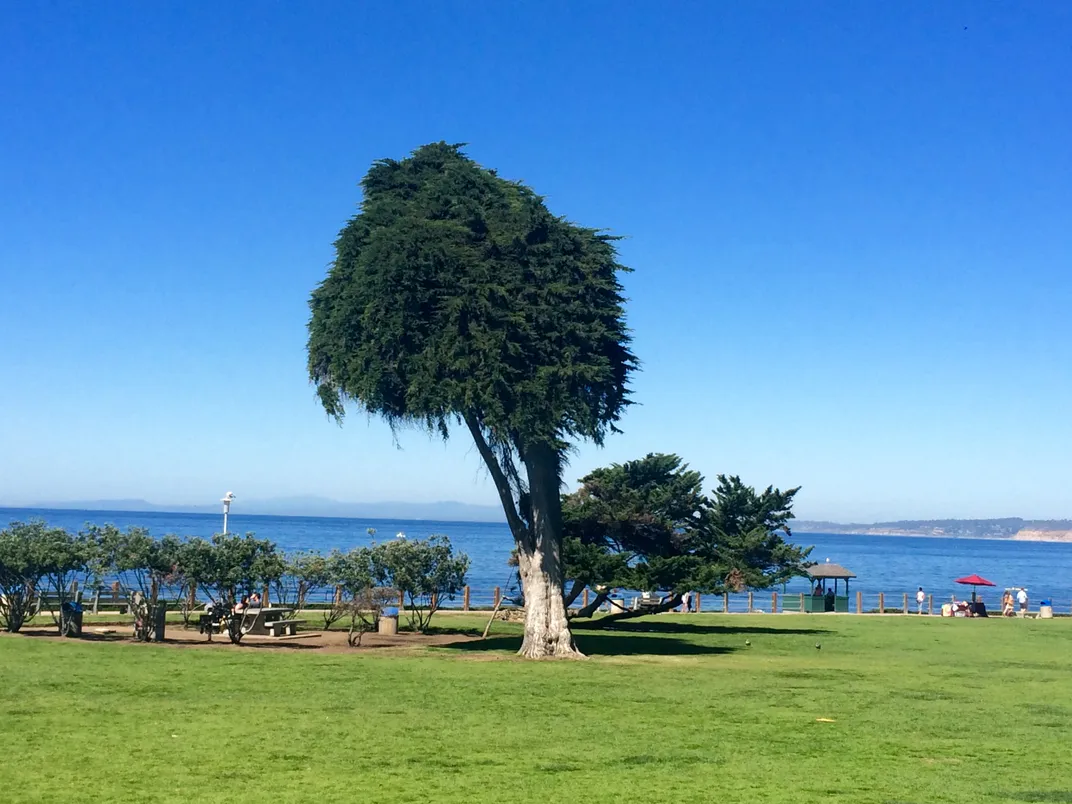Visit the Original Lorax Tree in Dr. Seuss’s San Diego
Check out these Seuss-related sites in Theodore Geisel’s adopted hometown
/https://tf-cmsv2-smithsonianmag-media.s3.amazonaws.com/filer/9d/15/9d1566c6-304d-4691-9b52-3ec8a98f8fef/lorax_tree-scripps_park_la_jolla.jpg)
In 1937, a long line of publishers rejected a children's book that would later become a classic. Penned by Theodore Geisel, And to Think That I Saw It on Mulberry Street immortalized a street in the author's hometown, Springfield, Massachusetts. The book was eventually picked up by a publisher, the first in a long line of classics penned by Geisel, a.k.a. Dr. Seuss.
His first book may have Massachusetts roots, but after World War II Geisel made his way to San Diego, California and moved into an observation tower in ritzy La Jolla. His newly adopted hometown became part of literary history, too. In this home and his studio on Mt. Soledad, Seuss wrote more than 40 children’s books—including the immortal The Cat in the Hat. And though he died in 1991, his legacy still looms large in both San Diego and the history of literature for kids.
“Seuss is the best selling and most influential children’s author in the United States,” Dr. Philip Nel, director of the children’s literature program at Kansas State University, tells Smithsonian.com. “He teaches children not only how to read but why and how to think. He wants children to take an interest in their world and make a better world.”
Unfortunately, Seuss’ San Diego home itself is not available to visit, but that doesn't mean you can't find traces of the fantastical creator of Sam I Am, The Grinch and Horton in the city he loved. Build your own Seussical San Diego tour with these stops around La Jolla:
Legends Gallery
As one of the mainstay exhibits in Legends Gallery in La Jolla, "The Secret Art of Dr. Seuss" brings together about 70 years of Geisel's paintings and sculptures. The collection shows how the author and illustrator expertly blended surrealism with children’s artwork. Though he created all the fantastical sculptures and paintings on display at the exhibit, none were s or shown or published during his lifetime. Legends Gallery's collection is truly a hidden testament to Seuss’ imaginative life.
Geisel Library

More than 8,500 items comprise the Dr. Seuss Collection at the Geisel Library at University of California, San Diego, in La Jolla. It’s the world’s largest collection of Seuss items and is filled with original manuscripts, drawings, notebooks, photos and more. The library was renamed after Seuss in 1995.
The items in the collection are reserved for researchers due to their fragility, but guests can take in a Seuss exhibit during the summer and in March (Seuss’ birth month) each year. Outside of the library, visit the life-size bronze Dr. Seuss statue—you'll spot him sitting at a desk next to a seven-and-a-half-foot-tall bronze Cat in the Hat.
The Original Lorax Tree

In Scripps Park, near where Dr. Seuss lived in La Jolla, a lone Lorax tree stands in the sun. OK, so Lorax trees aren’t really real, but this one is locally thought to be the inspiration for Geisel's classic conservation story. Instead belonging to the invented Truffula species, the tree is a rare Monterey Cyprus Cypress native to the California coast. Seuss could see this exact tree from the observation tower he lived in. And while there may be no plaque or official designation, ask anyone in town where the Lorax tree is, and they’ll point you here.
Hotel Del Coronado

Just south of San Diego in Coronado, you can get a first-hand glance at the inspiration for one of Seuss’ artworks, “I Dreamed I Was a Doorman at the Hotel del Coronado.” The painting portrays the 1888 Victorian Hotel del Coronado in its beachside setting with sharp angles and whimsical colors. Copies of the painting are currently sold out from the publisher, though, due to its popularity.
Planning Your Next Trip?
Explore great travel deals
Smithsonian magazine participates in affiliate link advertising programs. If you purchase an item through these links, we receive a commission.
/https://tf-cmsv2-smithsonianmag-media.s3.amazonaws.com/accounts/headshot/JenniferBillock.png)
/https://tf-cmsv2-smithsonianmag-media.s3.amazonaws.com/accounts/headshot/JenniferBillock.png)